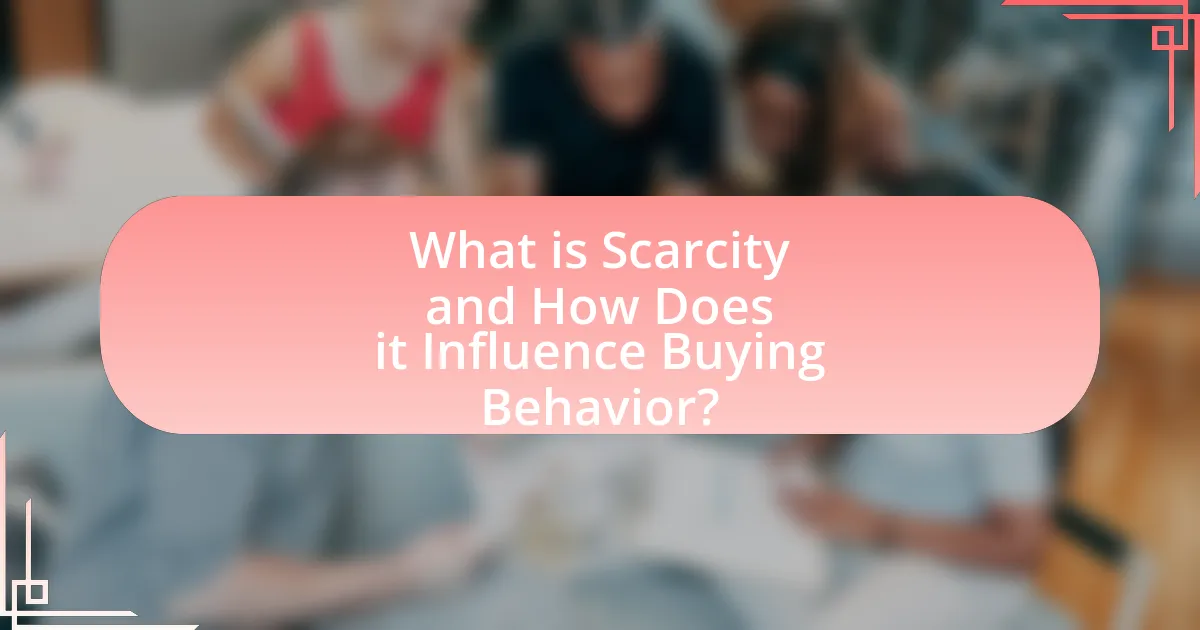Scarcity is defined as the limited availability of a product or resource, which enhances its perceived value and influences consumer buying behavior. This article explores how scarcity triggers urgency and fear of missing out, leading to quicker purchasing decisions. It examines the psychological principles behind scarcity, the types of scarcity in consumer markets, and the impact of perceived versus actual scarcity on decision-making. Additionally, the article discusses effective marketing strategies that leverage scarcity, the risks associated with misleading scarcity claims, and best practices for businesses to implement scarcity authentically while maintaining customer trust.

What is Scarcity and How Does it Influence Buying Behavior?
Scarcity refers to the limited availability of a product or resource, which creates a perception of increased value among consumers. This perception influences buying behavior by triggering urgency and a fear of missing out, leading consumers to make quicker purchasing decisions. Research indicates that when items are scarce, such as during limited-time offers or exclusive releases, consumers are more likely to perceive them as desirable, which can increase demand. For example, a study published in the Journal of Consumer Research found that consumers are willing to pay more for products that are presented as scarce, demonstrating that scarcity effectively drives purchasing behavior.
Why is Scarcity a Powerful Psychological Trigger in Marketing?
Scarcity is a powerful psychological trigger in marketing because it creates a sense of urgency and increases perceived value. When consumers believe that a product is limited in availability, they are more likely to act quickly to avoid missing out, which can lead to impulsive purchasing decisions. Research by Cialdini (2009) highlights that scarcity enhances desirability; items that are less available are often viewed as more valuable. This principle is evident in marketing strategies such as limited-time offers or exclusive releases, which leverage the fear of missing out (FOMO) to drive sales.
What are the psychological principles behind scarcity?
The psychological principles behind scarcity include the concepts of perceived value, urgency, and competition. Scarcity increases the perceived value of an item, as individuals often associate limited availability with higher worth. This principle is supported by research from Cialdini, which indicates that people are more likely to desire items that are less available, leading to a heightened sense of urgency to acquire them. Additionally, scarcity creates a competitive environment where individuals feel compelled to act quickly to secure the limited resource, further driving demand. This behavior is evident in marketing strategies that emphasize limited-time offers or exclusive products, reinforcing the notion that scarcity can significantly influence consumer decision-making and buying behavior.
How does scarcity create a sense of urgency in consumers?
Scarcity creates a sense of urgency in consumers by triggering a fear of missing out, which compels them to act quickly. When products are perceived as limited in availability, consumers often believe that they may not have another opportunity to purchase those items, leading to impulsive buying decisions. Research by Cialdini (2009) indicates that scarcity increases the perceived value of an item, making it more desirable. This psychological response is rooted in the principle of loss aversion, where the potential loss of an opportunity outweighs the potential gain of waiting. Consequently, consumers are more likely to make immediate purchases when they perceive that a product is scarce.
What Types of Scarcity Exist in Consumer Markets?
There are two primary types of scarcity that exist in consumer markets: absolute scarcity and relative scarcity. Absolute scarcity occurs when a product is completely unavailable, such as when a natural disaster disrupts supply chains, leading to a total lack of certain goods. Relative scarcity, on the other hand, refers to a situation where a product is available but in limited quantities compared to demand, such as limited edition items or seasonal products. Both types of scarcity significantly influence consumer behavior, as they create urgency and can drive up demand, often leading to increased prices and heightened competition among buyers.
What is perceived scarcity versus actual scarcity?
Perceived scarcity refers to the belief that a product or resource is limited, influencing consumer behavior through urgency and desire, while actual scarcity is the true limitation of availability. Research indicates that perceived scarcity can drive demand even when the actual supply is sufficient, as seen in marketing strategies where limited-time offers create a sense of urgency. For example, a study published in the Journal of Consumer Research by Cialdini et al. (2006) demonstrates that consumers are more likely to purchase items labeled as “limited edition” despite the actual availability being high. This distinction highlights how psychological factors can significantly impact buying behavior, often leading consumers to act based on perception rather than reality.
How do limited-time offers and limited-quantity offers differ?
Limited-time offers and limited-quantity offers differ primarily in their focus on time versus availability. Limited-time offers create urgency by providing a specific timeframe during which a product or service is available at a discounted rate, compelling consumers to act quickly to avoid missing out. For example, a retailer may offer a 24-hour sale on select items, motivating customers to purchase before the deadline. In contrast, limited-quantity offers emphasize the scarcity of the product itself, where only a certain number of items are available for purchase, regardless of time. An example is a flash sale where only 100 units of a product are sold, encouraging consumers to buy immediately to secure their item before it runs out. Both strategies leverage scarcity to influence buying behavior, but they do so through different mechanisms: urgency in time for limited-time offers and urgency in availability for limited-quantity offers.
How Does Scarcity Affect Consumer Decision-Making?
Scarcity significantly influences consumer decision-making by creating a sense of urgency that drives individuals to act quickly. When consumers perceive a product as limited in availability, they often experience increased desire and fear of missing out, which can lead to impulsive purchases. Research by Cialdini (2009) in “Influence: Science and Practice” indicates that scarcity enhances the perceived value of an item, making it more attractive. This psychological effect is evident in marketing strategies that highlight limited-time offers or exclusive products, which can lead to higher sales and faster decision-making among consumers.
What role does scarcity play in impulse buying?
Scarcity significantly increases impulse buying by creating a sense of urgency and fear of missing out. When consumers perceive that a product is limited in availability, they are more likely to make quick purchasing decisions to avoid losing the opportunity. Research indicates that limited-time offers or low stock alerts can trigger emotional responses that override rational decision-making, leading to impulsive purchases. For instance, a study published in the Journal of Consumer Research found that consumers are more likely to buy products labeled as “limited edition” or “only a few left” due to heightened perceived value and urgency.
How does scarcity influence perceived value of products?
Scarcity significantly increases the perceived value of products. When items are limited in availability, consumers often associate them with higher quality and exclusivity, leading to a heightened desire to acquire them. Research by Cialdini et al. (1975) demonstrated that people are more likely to want items that are scarce, as they perceive them as more valuable due to their limited nature. This psychological principle is rooted in the fear of missing out, which drives consumers to act quickly to secure scarce products, further enhancing their perceived worth.
How Can Businesses Leverage Scarcity in Their Marketing Strategies?
Businesses can leverage scarcity in their marketing strategies by creating a sense of urgency around their products or services. This can be achieved through limited-time offers, exclusive releases, or highlighting low stock levels. Research indicates that scarcity can significantly increase consumer demand; for example, a study published in the Journal of Consumer Research found that products perceived as scarce are often viewed as more valuable, leading to higher purchase intentions. By effectively communicating scarcity, businesses can motivate consumers to act quickly, thereby enhancing sales and customer engagement.
What are effective ways to implement scarcity in promotions?
Effective ways to implement scarcity in promotions include limited-time offers, exclusive access, and low-stock alerts. Limited-time offers create urgency by encouraging consumers to act quickly, as seen in studies showing that time constraints can increase purchase likelihood. Exclusive access, such as members-only sales, enhances perceived value and desirability, supported by research indicating that exclusivity can drive consumer engagement. Low-stock alerts inform customers about dwindling inventory, leveraging the fear of missing out, which has been shown to significantly boost sales conversions.
How can businesses balance scarcity with customer satisfaction?
Businesses can balance scarcity with customer satisfaction by implementing strategic inventory management and effective communication. By carefully managing stock levels to create a sense of urgency without completely depleting resources, businesses can encourage purchases while still meeting customer demand. For instance, limited-time offers or exclusive products can drive sales while maintaining customer interest. Research indicates that perceived scarcity can enhance desirability; a study published in the Journal of Consumer Research found that consumers are more likely to purchase items they believe are in limited supply. This approach not only boosts sales but also fosters a positive customer experience by ensuring that customers feel valued and informed about product availability.

What Are the Risks of Using Scarcity in Marketing?
The risks of using scarcity in marketing include potential customer backlash, diminished brand trust, and the possibility of misleading consumers. When marketers create a false sense of urgency, customers may feel manipulated, leading to negative perceptions of the brand. Research indicates that 60% of consumers report feeling frustrated when they believe a scarcity tactic is deceptive, which can result in lost sales and damaged reputation. Additionally, overuse of scarcity can lead to desensitization, where consumers become skeptical of future promotions, ultimately reducing the effectiveness of marketing strategies.
What negative impacts can arise from overusing scarcity tactics?
Overusing scarcity tactics can lead to consumer skepticism and diminished trust in a brand. When consumers frequently encounter artificial scarcity, they may begin to question the authenticity of the offers, perceiving them as manipulative rather than genuine. Research indicates that excessive reliance on scarcity can result in negative brand perception, as customers feel pressured and manipulated, which can ultimately lead to decreased customer loyalty. A study published in the Journal of Consumer Research found that consumers exposed to repeated scarcity messages reported lower satisfaction and a higher likelihood of negative word-of-mouth about the brand.
How can false scarcity damage brand reputation?
False scarcity can significantly damage brand reputation by eroding consumer trust. When brands create an illusion of limited availability, customers may feel manipulated once they realize the scarcity is not genuine. This perception can lead to negative word-of-mouth, as dissatisfied customers share their experiences, which can be amplified through social media. Research indicates that 70% of consumers are more likely to share negative experiences than positive ones, highlighting the potential for widespread reputational harm. Additionally, brands that rely on false scarcity risk being perceived as dishonest, which can deter future purchases and loyalty, ultimately impacting long-term profitability.
What are the potential legal implications of misleading scarcity claims?
Misleading scarcity claims can lead to significant legal implications, including false advertising and consumer deception violations. Regulatory bodies, such as the Federal Trade Commission (FTC) in the United States, enforce laws against deceptive marketing practices, which can result in fines, penalties, and mandatory corrective advertising. For instance, the FTC has previously taken action against companies for creating artificial scarcity to manipulate consumer behavior, emphasizing that such practices can mislead consumers about the availability of products. Additionally, consumers may pursue legal action for damages if they feel misled by these claims, potentially resulting in class-action lawsuits.
How Can Businesses Measure the Effectiveness of Scarcity Strategies?
Businesses can measure the effectiveness of scarcity strategies by analyzing key performance indicators such as sales volume, conversion rates, and customer engagement metrics. For instance, a study by Cialdini et al. (2006) demonstrated that limited-time offers significantly increased purchase intentions, indicating that scarcity can drive consumer behavior. Additionally, businesses can track changes in website traffic and social media interactions during scarcity campaigns to assess their impact. By comparing these metrics before, during, and after implementing scarcity strategies, companies can quantify their effectiveness and make informed decisions for future marketing efforts.
What metrics should be tracked to assess the impact of scarcity on sales?
To assess the impact of scarcity on sales, key metrics to track include conversion rate, sales velocity, inventory turnover, and customer engagement levels. Conversion rate measures the percentage of visitors who make a purchase, indicating how scarcity influences buying decisions. Sales velocity, which reflects the speed at which products sell, can show how urgency affects consumer behavior. Inventory turnover assesses how quickly stock is sold and replaced, providing insight into demand driven by scarcity. Customer engagement levels, such as time spent on product pages or social media interactions, can reveal how scarcity messaging resonates with potential buyers. These metrics collectively provide a comprehensive view of how scarcity influences sales performance.
How can customer feedback inform the use of scarcity tactics?
Customer feedback can inform the use of scarcity tactics by revealing customer perceptions and preferences regarding product availability. Analyzing feedback allows businesses to identify which products customers feel are genuinely scarce and which may be perceived as artificially limited. For instance, a study by Cialdini et al. (2006) highlights that perceived scarcity can enhance desirability, but if customers feel manipulated, it can lead to distrust. Therefore, businesses can adjust their scarcity tactics based on feedback to ensure authenticity, thereby increasing effectiveness and maintaining customer trust.

What Best Practices Should Businesses Follow When Implementing Scarcity?
Businesses should create genuine scarcity by limiting product availability and clearly communicating this to consumers. This practice enhances perceived value and urgency, driving quicker purchasing decisions. For instance, a study by Cialdini (2009) highlights that limited-time offers can significantly increase sales, as consumers fear missing out on exclusive opportunities. Additionally, businesses should ensure that the scarcity is authentic; artificial scarcity can lead to customer distrust and damage brand reputation. By employing these best practices, businesses can effectively leverage scarcity to influence buying behavior positively.
How can businesses create authentic scarcity without misleading consumers?
Businesses can create authentic scarcity without misleading consumers by implementing limited-time offers or exclusive product releases that are genuinely constrained in availability. For instance, a company can announce a seasonal product that is only available for a specific period, ensuring that consumers understand the time-sensitive nature of the offer. This approach is supported by research indicating that limited availability can enhance perceived value and urgency, as seen in studies by Cialdini (2009) which highlight how scarcity can drive consumer demand. By clearly communicating the reasons for scarcity, such as production limits or seasonal availability, businesses maintain transparency and build trust with consumers, thereby avoiding misleading practices.
What are some examples of successful scarcity campaigns?
Some examples of successful scarcity campaigns include the limited-time offers by Amazon during Prime Day, which generated over $11 billion in sales in 2021, and the “limited edition” sneaker releases by Nike, which often sell out within minutes, creating a sense of urgency among consumers. Another notable example is the “only 5 left in stock” message used by various e-commerce platforms, which has been shown to increase conversion rates by up to 300%. These campaigns effectively leverage the principle of scarcity to drive consumer behavior and increase sales.
How can businesses ensure transparency while using scarcity tactics?
Businesses can ensure transparency while using scarcity tactics by clearly communicating the reasons behind the scarcity and providing accurate information about product availability. For instance, if a business advertises a limited-time offer, it should specify the exact number of items available or the timeframe for the promotion. This approach builds trust with consumers, as studies show that transparency in marketing can enhance customer loyalty and satisfaction. According to a 2020 survey by Label Insight, 94% of consumers are more likely to be loyal to a brand that offers complete transparency. By being upfront about scarcity, businesses can effectively leverage these tactics without misleading customers.
What Practical Tips Can Help Businesses Effectively Use Scarcity?
To effectively use scarcity, businesses should implement limited-time offers, highlight low stock levels, and create exclusive products. Limited-time offers create urgency, prompting consumers to act quickly; for example, a study by Cialdini (2009) shows that urgency can increase sales by up to 50%. Highlighting low stock levels, such as displaying “only 3 left in stock,” leverages the fear of missing out, which can drive purchases. Additionally, creating exclusive products or services, such as limited edition items, fosters a sense of uniqueness and desirability, enhancing perceived value. These strategies are supported by behavioral economics, which indicates that scarcity can significantly influence consumer decision-making.
How can businesses test different scarcity approaches for effectiveness?
Businesses can test different scarcity approaches for effectiveness by conducting A/B testing on marketing campaigns that utilize various scarcity tactics, such as limited-time offers or low-stock alerts. This method allows businesses to compare consumer responses to different scarcity messages in real-time, measuring metrics like conversion rates, average order value, and customer engagement. For instance, a study by Cialdini et al. (2006) demonstrated that perceived scarcity significantly increases demand, indicating that testing these approaches can yield valuable insights into consumer behavior. By analyzing the data collected from these tests, businesses can identify which scarcity strategies resonate most with their target audience and optimize their marketing efforts accordingly.
What are common pitfalls to avoid when using scarcity in marketing?
Common pitfalls to avoid when using scarcity in marketing include overusing scarcity tactics, which can lead to consumer skepticism. When marketers frequently claim limited availability, customers may begin to doubt the authenticity of these claims, reducing their effectiveness. Additionally, failing to create genuine urgency can result in missed sales opportunities; if consumers perceive that the scarcity is artificial, they may delay their purchases. Misleading consumers about product availability can also damage brand trust, as studies show that transparency is crucial for maintaining customer loyalty. Lastly, neglecting to balance scarcity with value can lead to negative perceptions; if customers feel pressured without understanding the benefits, they may abandon their purchases.


